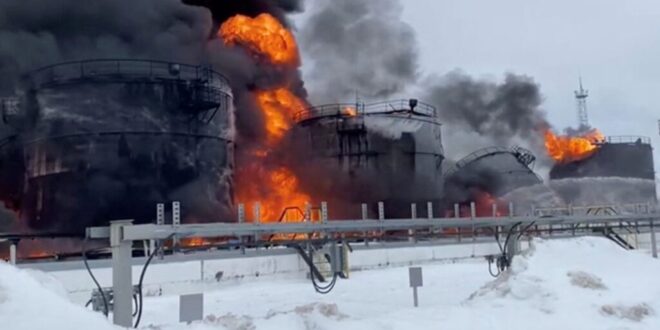Ukrainian drones struck a major oil refinery in southern Russia early on January 25, sparking a blaze that highlighted an emerging new front in the war unleashed by Vladimir Putin almost two years ago. The incident was the latest in a series of recent attacks on Russian energy infrastructure as Ukraine seeks to bring the war home to Russia by targeting the country’s vital but vulnerable oil and gas industry.
Since the start of 2024, Ukraine has launched a number of drone strikes on energy facilities across Russia. These have included the first successful attacks on targets close to St. Petersburg, almost one thousand kilometers away from the Ukrainian border. Officials at Russian energy company Novatek confirmed on January 20 that they had been forced to temporarily suspend some operations at the huge Ust-Luga fuel export terminal on the Gulf of Finland due to a fire started by Ukrainian drones.
This unfolding drone campaign aims to hamper the ongoing Russian invasion of Ukraine, while also dealing a painful economic blow to the Putin regime. By using long-range drones to strike energy facilities across Russia, Ukraine seeks to disrupt the logistical networks supplying Putin’s invasion force and reduce the mobility of the Russian army in Ukraine.
Many in Kyiv believe the potential to cause economic mayhem is even greater. The Russian economy is heavily reliant on the energy sector, making it an obvious and attractive target for Ukrainian military planners. Russia’s oil and gas industry has so far proven remarkably resistant to Western sanctions, with clients from the Global South stepping in to replace exiting European customers. Ukrainians hope their far more direct approach will now succeed where sanctions have failed and impose crippling costs on the Kremlin.
Kyiv’s recent attempts to expand attacks on energy targets inside Russia are in part a reflection of unfavorable battlefield realities. The failure of the much-hyped Ukrainian counteroffensive in the second half of 2023 forced the country’s commanders to acknowledge that the war had reached a stalemate. Meanwhile, the future of international military aid to Ukraine is now in doubt amid mounting political obstacles, leaving front line troops increasingly outgunned and forced to ration limited ammunition. With little choice but to adopt a strategy of active defense, long-range drone strikes against strategic targets inside Russia offer Ukraine an opportunity to break the deadlock and undermine Putin’s war machine.
This kind of asymmetrical warfare plays to Ukraine’s strengths while exploiting Russia’s weaknesses. The long-neglected Ukrainian arms industry has been unable to keep pace with the unprecedented demands of Russia’s full-scale invasion, but the country has managed to develop impressive domestic drone production capabilities. Government initiatives like the BRAVE1 hub are helping to support private sector efforts and harnessing the huge potential of Ukraine’s vibrant tech sector.
This emphasis on defense tech is enabling Ukraine to keep pace with its far wealthier adversary in what is widely seen as the world’s first drone war. Innovations are a daily feature of the contest between Russian and Ukrainian drone warriors, with both sides struggling to counter the latest enemy developments while implementing their own upgrades. For Ukraine, range has been a key factor. Recent drone attacks demonstrate that Kyiv now has the ability to hit targets throughout European Russia, where the vast majority of the country’s energy assets are located.
Ukrainian drone attacks on Russia’s energy infrastructure are creating serious headaches for the Kremlin. Russia’s vastness and the sheer size of the country’s energy industry make it virtually impossible to provide all possible targets with adequate air defenses. The problem is further complicated by the fact that the bulk of Russia’s air defense systems have already been deployed to occupied Crimea and the front lines in Ukraine. If Ukraine’s current bombing campaign continues to gather momentum, Russian military chiefs will have to decide whether to reduce protection for the army in Ukraine or leave critical infrastructure on the home front exposed to potential attack.
Crucially, the use of domestically produced drones enables Ukraine to minimize any potential protests from the country’s international partners, who have consistently sought to prevent Kyiv from using Western weapons inside Russia due to escalation fears. While Ukrainian leaders remain sensitive to these concerns, they have long expressed frustration over what many regard as excessive caution among Ukraine’s Western allies. Speaking at the recent World Economic Forum in Davos, President Zelenskyy complained that the West’s emphasis on avoiding escalation at all costs had resulted in countless missed opportunities while emboldening the Kremlin. “Every ‘don’t escalate’ addressed to us, sounded like ‘you will prevail’ to Putin,” he commented.
Ukraine’s decision to target Russia’s energy infrastructure is one of the boldest moves of the entire war. For almost two years, hostilities have been largely confined to Ukraine itself. That now appears to be changing. So far, Ukraine’s drone strikes are too small in scale to seriously damage the Russian war effort. Nevertheless, the recent flurry of attacks inside Russia crosses a major red line and marks a new phase in the conflict. The oil and gas industry has long fueled Russia’s resurgence on the international stage; Ukrainians are now hoping it will become Putin’s Achilles Heel.
 Eurasia Press & News
Eurasia Press & News


